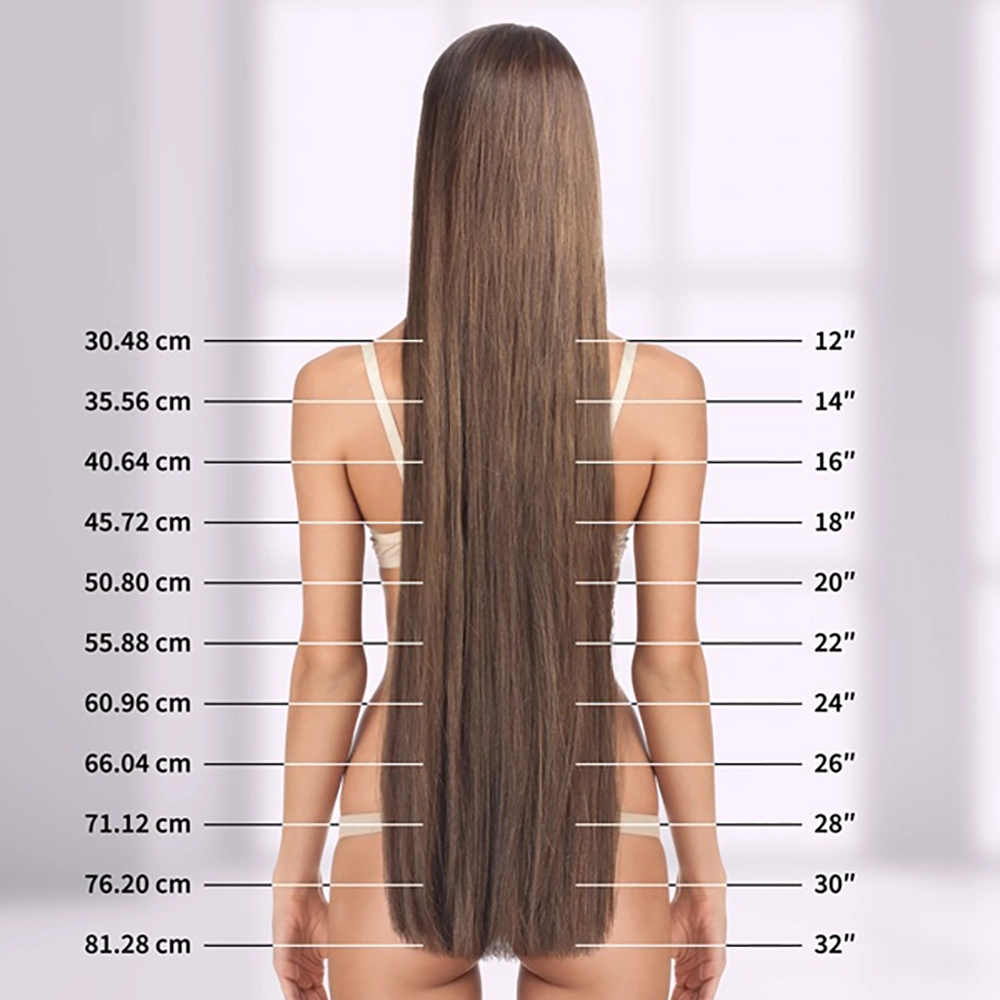Understanding measuring hair length accurately
When it comes to measuring hair length accurately, it is important to understand the proper techniques and tools involved. Whether you are a hairstylist, a hair enthusiast, or someone looking to track their hair growth progress, having the right knowledge and methods are essential. In this blog post, we will explore the different factors to consider and the common mistakes to avoid when measuring hair length.
The first step in accurately measuring hair length is to choose the right tools for the job. While there are various methods that can be used, it is recommended to use a measuring tape specifically designed for hair measurements. This type of measuring tape is flexible and allows for easy maneuverability around the head. Additionally, using a comb to separate the hair into sections can help ensure consistent measurements throughout the process.
Once you have the necessary tools, it is important to understand the proper technique for measuring hair length. Begin by parting the hair in the middle and combing it down to ensure a neat and even distribution. Take the measuring tape and starting from the roots, gently stretch it to the tip of the hair strands. Avoid pulling or tugging on the hair, as this can cause inaccurate measurements. Repeat this process for multiple sections of the head to get a comprehensive understanding of the overall hair length.
There are several factors to consider when measuring hair length accurately. One important factor is the type of hairstyle or haircut. If the hair is layered or styled in a way that makes it difficult to measure from root to tip, consider measuring the longest layer instead. Another factor to consider is the texture of the hair. Curly or wavy hair tends to have a shorter appearance when stretched, so it may be necessary to measure from a slightly different angle to compensate for the texture.
Choosing the right tools for hair measurement
When it comes to measuring hair length accurately, using the right tools is crucial. Not only does it ensure precision, but it also helps in getting consistent results. There are several essential tools that can assist you in accurately measuring hair length. Let’s explore some of these tools and understand their importance.
The first tool you should consider is a measuring tape specifically designed for hair. These measuring tapes are usually flexible and have clear markings, making it easy to measure hair length. They come in different lengths, so choose one that suits your needs. Another handy tool is a ruler or a comb with measurements. These tools are particularly useful for measuring small sections of hair or for measuring hair length when styling.
Another important tool to consider is a mirror. While it may not directly measure hair length, a mirror is essential in ensuring accurate measurements. By using a mirror, you can view the back of your head and make sure that your measurements are consistent from all angles. This is especially important if you’re measuring your own hair.
Step-by-step guide to measuring hair length
Measuring hair length accurately is an important aspect of hair care and styling. Whether you are trying to track your hair growth progress or simply want to determine the length for a specific hairstyle, having precise measurements is crucial. In this step-by-step guide, we will walk you through the process of measuring your hair length effectively.
The first step in measuring hair length is to gather the necessary tools. Tape measure and hair clips are the most common tools used for this purpose. It is important to choose a tape measure that is flexible and easy to handle. Hair clips come in handy to section off different parts of the hair for accurate measurement.
Once you have the tools ready, follow these steps:
- Start with clean, dry hair: Make sure your hair is freshly washed and completely dry. Wet or damp hair can stretch, resulting in inaccurate measurements.
- Divide your hair into sections: Use hair clips to divide your hair into manageable sections. This will help you measure each section individually.
- Begin measuring: Take the tape measure and place the starting point at the base of your hairline. Gently pull the tape measure all the way down until you reach the desired endpoint. Be careful not to pull too hard or stretch the hair.
- Record the measurement: Note down the measurement for each section of your hair. This will help you keep track of the length for future reference.
- Calculate the overall length: If you want to determine the overall hair length, add up the measurements of all the sections.
It is important to consider certain factors to ensure precise hair measurements. Avoid measuring curly or wavy hair when it is stretched out, as this can give inaccurate results. It is best to measure curly or wavy hair in its natural state. Additionally, avoid measuring hair with excessive product buildup, as this can affect the accuracy of the measurements.
By following this step-by-step guide, you can accurately measure your hair length and track your hair growth progress over time. Remember to measure your hair at regular intervals to monitor its growth and make informed decisions regarding styling and care. Happy measuring!
Factors to consider for precise hair measurements
When it comes to measuring hair length accurately, there are several factors that need to be considered in order to ensure precise measurements. These factors are crucial in obtaining accurate results and can greatly impact the overall measurement process.
One of the most important factors to consider is the type of hair being measured. Different hair types, such as curly, straight, or wavy, can affect the way hair appears in length. Curly hair tends to have more shrinkage, meaning it may appear shorter than it actually is when stretched. On the other hand, straight hair may appear longer due to its lack of shrinkage. Understanding the unique characteristics of different hair types is essential in obtaining precise measurements.
Another factor to consider is the method of measurement. There are several tools and techniques available for measuring hair length, such as using a tape measure, ruler, or even visually estimating. However, it is important to choose the right tools for accurate measurements. Using the appropriate measuring tool and technique based on the purpose of the measurement can greatly impact the precision of the results.
In addition to hair type and measurement method, external factors can also affect the accuracy of hair measurements. These include factors such as hair styling, product usage, and environmental conditions. For example, using heat styling tools or certain hair products can temporarily alter the length and texture of the hair, affecting the measurement results. Considering these external influences and ensuring consistency in measurement conditions can help in obtaining precise hair measurements.
- Choose the right tools: Selecting the appropriate measuring tool based on the purpose of the measurement.
- Understand hair type: Recognize the unique characteristics of different hair types and how they can impact measurements.
- Consider external factors: Take into account factors such as hair styling, product usage, and environmental conditions that can affect measurement accuracy.
| Factors to Consider | Importance |
|---|---|
| Hair type | Crucial in understanding how different hair types can affect measurement results. |
| Measurement method | The choice of measuring tool and technique can greatly impact precision. |
| External factors | Acknowledging external influences can help in obtaining accurate measurements. |
Common mistakes to avoid while measuring hair length
When it comes to measuring hair length, accuracy is key. Whether you are trying to track your hair growth progress or simply want to know the length of your hair for styling purposes, it’s important to avoid common mistakes that can throw off your measurements.
One of the most common mistakes people make when measuring hair length is not starting from the right point. To get an accurate measurement, you should start from the root of your hair instead of starting from any other point, such as the ends or a specific spot on your head. Starting from the root ensures that you are measuring the full length of your hair.
Another mistake to avoid is not pulling the hair taut while measuring. When hair is left loose or not properly stretched, it can appear longer than it actually is. To get an accurate measurement, make sure to pull the hair taut while measuring. This will give you a more precise measurement of your hair length.
In addition to these mistakes, using the wrong tools can also lead to inaccurate measurements. Using a measuring tape or ruler with small or unclear markings can result in imprecise measurements. It’s important to choose the right tools for hair measurement, such as a flexible measuring tape or ruler with clear markings. These tools will help you take accurate measurements and avoid any guesswork.
In summary, when measuring hair length, it’s important to avoid common mistakes that can affect the accuracy of your measurements. Start from the root of your hair, pull the hair taut while measuring, and choose the right tools for accurate measurements. By following these guidelines, you can ensure that your hair length measurements are precise and reliable.
Using alternative methods for hair length measurement
When it comes to measuring hair length, there are several traditional methods that people commonly use. However, in recent years, alternative methods for hair length measurement have gained popularity. These alternative methods offer a fresh approach to accurately measuring hair length and can be a great option for those who are looking for something different. In this blog post, we will explore some of the alternative methods for measuring hair length and discuss their benefits.
One alternative method for measuring hair length is using a string or ribbon. Simply cut a piece of string or ribbon that is the desired length of your hair. Then, place one end of the string or ribbon at the root of your hair and hold it there while extending the other end until it reaches the tip of your hair. Once you have determined the length, you can measure the string or ribbon using a ruler or tape measure to get an accurate measurement. This method is particularly useful for those who have curly or wavy hair, as it allows for a more precise measurement.
Another alternative method for measuring hair length is using a hair length chart. These charts typically consist of a series of images or illustrations that show different hair lengths. To use a hair length chart, simply compare the length of your hair to the images provided and determine which image is the closest match. This method is especially helpful for those who are not as familiar with traditional measurements or prefer a visual representation of their hair length.
In addition to the string and hair length chart methods, there are also various mobile apps and online tools available for measuring hair length. These tools typically use advanced technologies such as augmented reality or artificial intelligence to accurately measure the length of your hair. Users can simply upload a photo of their hair and the app or tool will automatically calculate the length. This method is convenient and can provide accurate measurements without the need for any physical tools.
Overall, alternative methods for hair length measurement offer new and innovative ways to accurately measure and track hair growth. Whether it’s using a string, a hair length chart, or a mobile app, these methods provide flexibility and convenience for individuals looking to monitor their hair length. So, if you’re tired of the traditional methods or simply want to try something different, give these alternative methods a try and see which one works best for you.
Tracking hair growth progress with accurate measurements
Tracking hair growth progress with accurate measurements is essential for anyone who wants to achieve long and healthy hair. Whether you are trying to grow out a short haircut, dealing with hair loss, or simply want to keep tabs on the health of your hair, measuring its length regularly can provide valuable insights. In this blog post, we will discuss why accurate measurements are important, how to properly measure your hair, and tips for tracking your hair growth progress effectively.
One of the key reasons why accurate measurements are crucial for tracking hair growth progress is to establish a baseline. By measuring your hair at the start of your hair growth journey, you will have a starting point to compare with future measurements. This baseline allows you to assess the effectiveness of different hair growth methods, products, and treatments. It also helps you determine whether your hair is growing at the desired rate.
When it comes to measuring your hair, using the right tools is essential. The most commonly used tool for hair measurement is a flexible measuring tape. This type of tape allows for easy manipulation around the curves of your head and provides precise measurements. Another option is using a ruler or a yardstick, especially if you prefer a more traditional approach. Whichever tool you choose, make sure it is easy to read and has clear markings for accurate measurements.
- Ensure your hair is dry and straight: Before taking measurements, make sure your hair is completely dry and straightened. This ensures consistency in your measurements and minimizes the chances of errors.
- Divide your hair into sections: To facilitate the measuring process, divide your hair into sections. This will help you ensure that you are measuring all parts of your hair equally.
- Measure from the same starting point: Consistency is key when it comes to tracking hair growth progress. Always measure from the same starting point, such as the center of your forehead or the tip of your ear.
Tracking your hair growth progress can be made even easier by creating a table or a spreadsheet to record your measurements. This allows you to visualize your progress over time and make comparisons between different measurement sessions. Include the date, length of your hair, and any notes or observations about your hair’s condition or any changes in your hair care routine.
In conclusion, tracking hair growth progress with accurate measurements is a valuable practice for anyone who wants to achieve their hair goals. By establishing a baseline, using the right tools, and following consistent measurement techniques, you can effectively monitor the health and length of your hair. Remember to be patient, as hair growth takes time, and maintaining a healthy hair care routine is just as important as measuring your hair length. Happy tracking!




































